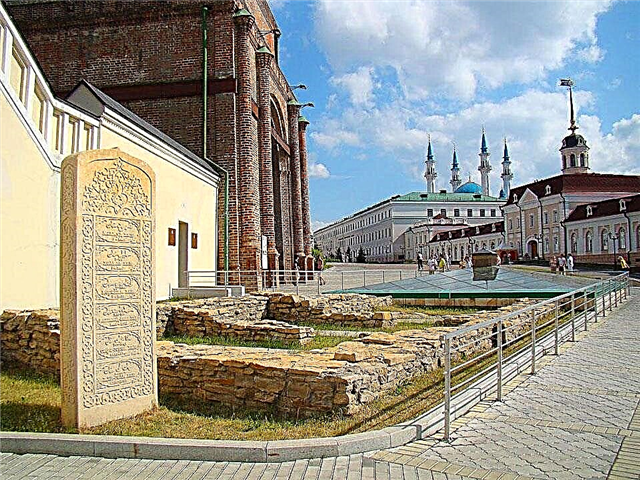Address: Russia, Pskov region, Pushkinogorsk district, village Mikhailovskoe
Foundation date: 1742 year
Main attractions: house-museum of A.S. Pushkin with a museum exposition, house of Pushkin's nanny - Arina Rodionovna, orchard and park
Coordinates: 57 ° 03'39.1 "N 28 ° 55'09.9" E
Cultural heritage site of the Russian Federation
Content:
The first time Pushkin came to the estate of young men, after graduating from the Tsarskoye Selo Lyceum. Then he returned here many times and even spent two whole years of exile in the Hannibals' nest. Among the wonderful nature, the poet could retire from the state-owned Petersburg, write a lot and not worry about anything. Mikhailovskoye became the place where he created about 200 poems.

House-Museum of A.S. Pushkin
History of the old estate
The surrounding lands belonged to Pushkin's maternal ancestors. In 1742, the Russian empress Elizabeth handed them over to the poet's great-grandfather, Abram Hannibal. When the first owner of the estate died, one of his sons, Osip, began to manage it. Under him, a manor house was rebuilt on the estate and a beautiful park was laid out. And in 1818, the mother of the young poet, Nadezhda Osipovna, became a full-fledged mistress.
The poet first came to the estate at the age of 18. Here he spent a two-year exile in the mid-1820s, and visited this place many times afterward, because he loved Mikhailovskoye and drew inspiration from these places. In the estate, the poet was able to finish the famous novel in verse "Eugene Onegin", created "Boris Godunov" and about two hundred more poems.

The southern facade of the house-museum of A.S. Pushkin
After the death of his mother in 1936, he briefly owned the estate together with his sister Olga and brother Lev. A year later, the poet himself was gone, the estate was bought for his children, but for more than two decades it stood ownerless. Finally, in the 1860s, the son of Alexander Sergeevich, Grigory, began to live on the estate. The large barn erected under him can be seen today.
In the year of the centenary of the poet's birth, the estate was acquired by the state. However, only a few years passed, and all the buildings burned down. The memorial house was rebuilt, and in 1911 a colony was founded here, where elderly writers lived, and the first museum was created. Then the fate of Russia changed dramatically, and many former values faded into the background. In 1918, the estate was burned down, only a small house remained intact, where the poet's nanny used to live.

Kern Alley
In 1937, for the centenary of the poet's death, his memorial house was restored again. But this building, as well as the nanny's house, did not survive during the German occupation, which the Pskov region was subjected to during the Great Patriotic War. Therefore, it should be admitted that nothing has survived from the buildings that Pushkin found in the estate.
The buildings that tourists coming to Mikhailovskoe can see were built thanks to the many years of work of the director Semyon Geychenko, who worked in this position from 1945 to 1993. Once again, the poet's house-museum was restored in its old place in 1949. Later, thanks to the efforts of the Pushkin scholar Geychenko, the rest of the manor-museum complex was re-created. Some of them have no historical basis, but reproduce, like Onegin's bench, famous literary images. The last restoration here took place on the occasion of the 200th anniversary of the poet, in 1999.

Spruce alley
Pushkin patrimony today
Today the estate has the status of a museum-reserve. On the territory of the Svyatogorsk Holy Dormition Monastery there are the poet's grave and the ancestral tomb of his ancestors. And in the estate itself there was a place for a museum house, a nanny's house, a manager's house and office, a stone barn and a colony of writers.
The Geychenko house with the collection of Russian samovars he collected became part of Mikhailovsky. In the newly rebuilt outbuilding, representing the human kitchen, you can see the old household utensils: basins for making jam, ladles, pots and wooden shovels. The main thing that has remained unchanged since the time of Pushkin and his ancestors is the picturesque nature of the Pskov lands and the magnificent Central Russian landscapes surrounding the estate.
House-museum
Authentic things that the poet owned are on display in his house-museum. This is an icon, which Pushkin's father blessed to marry Natasha Goncharova, as well as a metal cane weighing 4 kg. With her, the poet loved to walk around the neighborhood.

Seclusion island
The very first room where guests of the estate get to is dedicated to its history. The maiden's room displays skillful embroideries made by local craftswomen. In the room where the parents lived, one can learn about the history of the family and see portraits of the poet's ancestors. The living room and dining room tell about the time spent by Pushkin in the estate.
The most valuable memorial items are displayed in the study. This is a mahogany writing desk, an inkwell from the estate owned by the wife's relatives - the Goncharovs, a pedestal and a silver candlestick.
The park
It is impossible to feel the soul of the old manor without taking a walk in the picturesque park. From the place where all travelers come, the road to the center of the estate passes through a clearing and past a pond. The surroundings are clearly visible from the house-museum itself - the forested floodplain of Soroti, Lake Petrovskoe and Savkina Gorka.

Manor Bridge
The park located near the house was developed at the end of the 18th - beginning of the 19th centuries, and on its territory there are ancient burial mounds, which historians consider the burials of the Slavs who lived in the 5th-10th centuries. A huge oak tree has stood here since the Hannibal era, and the trees near the house were planted by Grigory Alexandrovich Pushkin in 1899.
The memorial part of the park is considered to be a linden alley, where Alexander Pushkin and Anna Kern walked in the summer of 1825. Lindens are so ancient that it is no longer possible to walk under them, because at any moment old branches can break off and fall.
From the Kern alley to the "Island of Solitude" through the Mikhailovsky Apple Orchard, a walking path is laid. Here is the favorite place of the guests of the estate - the young bronze Pushkin "lies" on the ground.
Next to the Kern Alley, there is another alley - a fir one, which leads to the chapel of the Archangel Michael. From here you can get to the Black Pond by a walking route. Nowadays, this place is chosen for nesting by gray herons, and in the warm season they bring their chicks to the pond.

Monument to A.S. Pushkin
Working hours
The manor complex receives guests every day, except Mondays, from 9.00 to 17.00. Ticket offices stop working half an hour earlier. The area is closed in April, November and on the last Tuesday of every month.
How to get there
Mikhailovskoye is located in the Pushkinogorsk region, 670 km from Moscow and 400 km from St. Petersburg. Regular buses run from Pskov to the village of Pushkinskie Gory. By car from Pskov you need to go through Ostrov and Novgorodka (distance 110 km).











